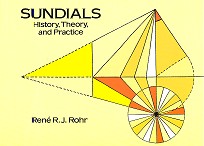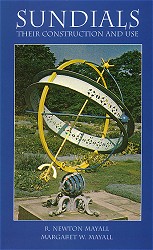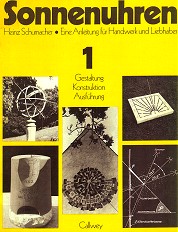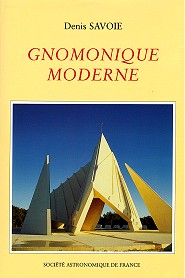Sundial links

This page has the following sections:

Sundial links
Instead of trying to keep long lists of sundial links up-to-date, I better refer you to sites that take better care of that. This section therefore is not too long.
Sundials on the Internet. Lots of information, and links to all important sites.
Sundial links by Daniel Roth. Over 300 links to sundial sites! New links are added on top.
Daniel Roth also hosts the Sundial Mailing List, a sometimes lively discussion group. See the relevant NASS page for subscribing and unsubscribing.
The website of the North American Sundial Society also features a list of sundial links, arranged by topic.
Make sure to visit the Sundial Park in Genk (Belgium), a major European attraction!
The Rupelmonde Sundial Trail (near Antwerp). The birthplace of the great cartographer Mercator is dotted with sundials. The website shows a dozen of the most interesting ones.
The collection of sundials in and around Bremen, many of them portrayed, is worth a visit.
 The Deutsches Museum in Munich has a sundial garden (a roof garden, actually) exhibiting 21 dials. They illustrate the development of the sundial from ancient times to the present.
The Deutsches Museum in Munich has a sundial garden (a roof garden, actually) exhibiting 21 dials. They illustrate the development of the sundial from ancient times to the present.
The website of the museum has a brief digital tour. The (hardcopy) guidebook sets out on a general introduction on sundials, followed by an explanation of each object: Sonnenuhrengarten. Führer durch die Ausstellung, Deutsches Museum, München 1999, ISBN 3-924183-49-X.

Literature on sundials
There are many classical sundial books, in English, German and French. Only few modern books have been published. 'Classical' are books that use exclusively geometric constructions, 'modern' are books that use mathematical (trigonometric) formulas. The latter are easy to implement in a spreadsheet program. Not to mention the many free ready-to-use computer programs available on the internet.
'Classical' also implies that no attention is given to 'modern' developments such as bifilar dials (1922), shadow plane dials (?) and the digital sundial (1994).
Dutch sundial books are listed in the Dutch version of this website.
I did not scrutinize all the books listed below, so don't expect thorough reviews, merely some points that drew my attention while browsing.

English
 Albert E. Waugh, Sundials: Their theory and construction, Dover Publications, New York 1973, ISBN 0-486-22947-5.
Albert E. Waugh, Sundials: Their theory and construction, Dover Publications, New York 1973, ISBN 0-486-22947-5.
My favorite guide. It has little background, but gives clear, step-by-step instructions on how to design your own dial, giving both geometric and mathematical recipes.
 R.R.J. Rohr, Sundials: History, theory and practice. Several editions exist; my copy is from Dover Publications, New York 1996, ISBN 0-486-29139-1.
R.R.J. Rohr, Sundials: History, theory and practice. Several editions exist; my copy is from Dover Publications, New York 1996, ISBN 0-486-29139-1.
It is the translation of the French original from 1965; German and Italian versions also exist. An authoritative book! Reading is hampered, however, by the odd format and the simultaneous use of figures and plates.
 R. Newton Mayall & Margaret W. Mayall, Sundials: Their construction and use, 3rd edition. Several editions exist; mine is from Dover Publications, New York 2000, ISBN 0-486-41146-X.
R. Newton Mayall & Margaret W. Mayall, Sundials: Their construction and use, 3rd edition. Several editions exist; mine is from Dover Publications, New York 2000, ISBN 0-486-41146-X.
The original edition was from 1938, which still is quite noticeable, if only from the quality of the black-and-white pictures. In the United States it is authoritative. It provides geometric as well as mathematical recipes.

German
 Arnold Zenkert, Faszination Sonnenuhr [The fascination of sundials], 3rd edition, Harri Deutsch, Thun/Frankfurt 2000, ISBN 3-8171-1579-2, including cd-rom.
Arnold Zenkert, Faszination Sonnenuhr [The fascination of sundials], 3rd edition, Harri Deutsch, Thun/Frankfurt 2000, ISBN 3-8171-1579-2, including cd-rom.
Very nice book, which also pays much attention to the practical aspects of constructing and installing dials. The cd offers some 100 color pictures of sundials of various types (with little commentary), as well as some cut-out dials for printing and the computer program CHRON by Harald Wislaug for calculating dials.
According to this book, Ptolemaeus (first century AD) invented the analemmatic dial, which was rediscovered around 1850 by French clock makers...
 Heinz Schumacher, Sonnenuhren: Eine Anleitung für Handwerk und Liebhaber [Sundials: a manual for construction and reference]. Vol. 1: Gestaltung, Konstruktion, Ausführung [Design, construction and installation]. 2nd edition, Callwey, München 1978, ISBN 3-7667-0-437-0.
Heinz Schumacher, Sonnenuhren: Eine Anleitung für Handwerk und Liebhaber [Sundials: a manual for construction and reference]. Vol. 1: Gestaltung, Konstruktion, Ausführung [Design, construction and installation]. 2nd edition, Callwey, München 1978, ISBN 3-7667-0-437-0.
Adolf Peitz, Vol. 2: Tabellen und Diagramme zur Berechnung [Tables and diagrams to calculate dials]. 2nd edition, Callwey, München 1983, ISBN 3-7667-0607-1.
Heinz Schumacher & Adolf Peitz, Vol. 3: 303 Beispiele aus 12 Ländern [303 Examples from 12 countries]. Callwey, München 1981, ISBN 3-7667-0570-9. All volumes have been sold out.
An impressive series! Volume 1 is neat and quite extensive, paying also attention to aspects that other books let go, such as the precision of sundials and the correct installation. This volume only uses geometric constructions. The classification is not very systematic; in the chapter on large horizontal dials one finds nodal dials together with horizontal pole-style dials and analemmatic dials, for instance. This volume has over 180 black-and-white pictures of sundials, intermingled in the text without direct relationship.
Volume 2 consists mainly of tables, for the latitude of Germany. Now probably superseded by the computer. In addition, several sundial types are presented which were not treated in vol. 1, such as analemmatic dials on vertical planes and related types such as the Foster-Lambert dial and the 'sun spider'.
Volume 3, finally, presents even more (black-and-white) pictures.

French
 Denis Savoie, Gnomonique moderne, Société Astronomique de France, Paris 1997, ISBN 2-901730-05-1.
Denis Savoie, Gnomonique moderne, Société Astronomique de France, Paris 1997, ISBN 2-901730-05-1.
'Modern' in the title refers to the purely mathematical approach: no geometric constructions anymore. Modern is also the extensive treatment of analemmatic dials and related types, and of bifilar dials. It is a real textbook: no distracting pictures. The only picture is the one on the cover, of the large dial near Tavel.

 The Deutsches Museum in Munich has a sundial garden (a roof garden, actually) exhibiting 21 dials. They illustrate the development of the sundial from ancient times to the present.
The Deutsches Museum in Munich has a sundial garden (a roof garden, actually) exhibiting 21 dials. They illustrate the development of the sundial from ancient times to the present. Albert E. Waugh, Sundials: Their theory and construction, Dover Publications, New York 1973, ISBN 0-486-22947-5.
Albert E. Waugh, Sundials: Their theory and construction, Dover Publications, New York 1973, ISBN 0-486-22947-5. R.R.J. Rohr, Sundials: History, theory and practice. Several editions exist; my copy is from Dover Publications, New York 1996, ISBN 0-486-29139-1.
R.R.J. Rohr, Sundials: History, theory and practice. Several editions exist; my copy is from Dover Publications, New York 1996, ISBN 0-486-29139-1. R. Newton Mayall & Margaret W. Mayall, Sundials: Their construction and use, 3rd edition. Several editions exist; mine is from Dover Publications, New York 2000, ISBN 0-486-41146-X.
R. Newton Mayall & Margaret W. Mayall, Sundials: Their construction and use, 3rd edition. Several editions exist; mine is from Dover Publications, New York 2000, ISBN 0-486-41146-X. Arnold Zenkert, Faszination Sonnenuhr [The fascination of sundials], 3rd edition, Harri Deutsch, Thun/Frankfurt 2000, ISBN 3-8171-1579-2, including cd-rom.
Arnold Zenkert, Faszination Sonnenuhr [The fascination of sundials], 3rd edition, Harri Deutsch, Thun/Frankfurt 2000, ISBN 3-8171-1579-2, including cd-rom. Heinz Schumacher, Sonnenuhren: Eine Anleitung für Handwerk und Liebhaber [Sundials: a manual for construction and reference]. Vol. 1: Gestaltung, Konstruktion, Ausführung [Design, construction and installation]. 2nd edition, Callwey, München 1978, ISBN 3-7667-0-437-0.
Heinz Schumacher, Sonnenuhren: Eine Anleitung für Handwerk und Liebhaber [Sundials: a manual for construction and reference]. Vol. 1: Gestaltung, Konstruktion, Ausführung [Design, construction and installation]. 2nd edition, Callwey, München 1978, ISBN 3-7667-0-437-0. Denis Savoie, Gnomonique moderne, Société Astronomique de France, Paris 1997, ISBN 2-901730-05-1.
Denis Savoie, Gnomonique moderne, Société Astronomique de France, Paris 1997, ISBN 2-901730-05-1.